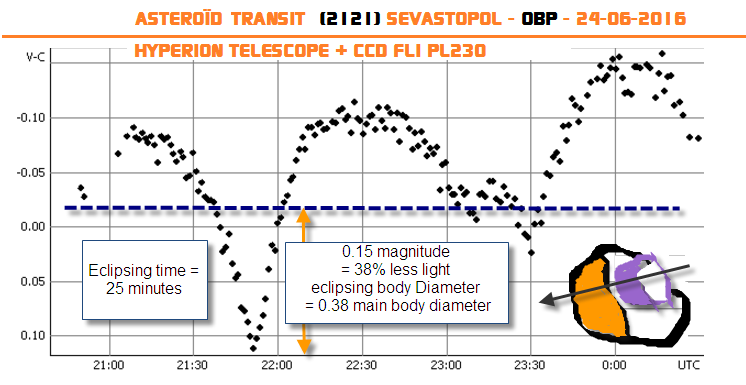Dans la nuit du 24 juin dernier un étonnant phénomène à été observé depuis la salle de contrôle à l'Observatoire des Baronnies Provençales. L'éclipse de l'astéroïde 2121 Sevastopol par son satellite. La période orbitale du deuxième corps est de 37 heures mais le phénomène a été vu dés la première heure des mesures photométriques. L'astéroïde principal mesure 8,5 km et le second 3,54 km soit en effet environ 40% du diamètre du premier. Sur la courbe de lumière mesurant les différences de luminosité du système on détecte facilement une perte brutale de magnitude de 0,15 en 10 minutes.
Validant ainsi le telegramme adressé au CBAT le 26 aout 2010 :
(2121) SEVASTOPOL
D. Higgins, Canberra, Australia; P. Pravec and P. Kusnirak, Ondrejov
Observatory; J. Pollock, Appalachian State University; J. Oey, Leura, N.S.W.,
Australia; M. Husarik and G. Cervak, Skalnate Pleso Observatory; and D. E.
Reichart, K. M. Ivarsen, J. B. Haislip, and A. LaCluyze, Physics and Astronomy
Department, University of North Carolina, Chapel Hill, report that photometric
observations obtained during July 23-Aug. 24 reveal that minor planet (2121)
is a binary system with an orbital period of 37.1 hr. The primary shows a
period of 2.90640 +/- 0.00002 hr, and it has a lightcurve amplitude of 0.20
mag. Mutual eclipse/occultation events that are 0.2-mag deep indicate a
secondary-to-primary mean-diameter ratio of 0.41 +/- 0.02. The secondary
rotates synchronously with the orbital motion and shows an amplitude of 0.06
mag in the combined lightcurve of the system. Due to the high solar phase,
the observed eclipse/occultation events also describe the satellite-shadow
transit and satellite's passage through the parent body's shadow.





/idata%2F4150642%2FWeek-End-Etoile%2FWeek-End-Etoile.JPG)
/idata%2F4150642%2FT820-CCD%2FDSCN8950.JPG)
/idata%2F4150642%2FCiel-Extreme%2FCroix-einstein.jpg)
/idata%2F4150642%2FObservatoire%2FObservatoire.jpg)
/idata%2F4150642%2FConstruction%2FPanorama.gif)
/idata%2F4150642%2FAlbum-photos-1%2FMeade-14-Paramount.jpg)

